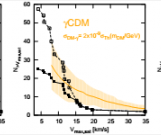Paper of the month: Solving the Milky Way Satellite Problem with Interactions between Cold Dark Matter and Radiation, by C. Boehm, J.A. Schewtschenko, R.J. Wilkinson, C.M. Baugh and S. Pascoli
May 16, 2014 by admin
A large body of evidence suggests that dark matter makes up around 80 percent of the matter content of the Universe and plays an important role in structure formation in the Universe. Cold dark matter (CDM) is a form of dark matter which consists of slow moving particles that interact gravitationally and through the weak force, and is the leading paradigm to explain the universe’s missing mass. Such weakly interacting particles are believed to have a small velocity dispersion and negligible free-streaming. Numerical simulations of CDM agree very well with observations of the largest scales in the Universe, such as galaxy clusterings. However, with numerical simulations gaining higher resolutions, important discrepancies between the predictions of the CDM model and observations of small scales in the Universe have been noticed.
One of the important challenges for the CDM paradigm is the “missing satellite problem”. CDM predicts a larger number of small “satellite galaxies” which would be orbiting the Milky Way compared to what is actually observed. Cosmological simulations incorporating collisionless CDM and gravity predict halos with a large amount of substructure on small scales, leading to hundreds or thousands of subhaloes compared to the observed ~10 satellites of the Milky Way. There are various approaches to tackle this problem. One explanation may be that subhaloes have faint galaxies which are not observable with current astronomical surveys, or that they don’t form galaxies at all because of supernovae heating the interstellar medium. One other possible explanation comes from the fact that the Milky Way halo mass affects the number of satellite galaxies, and since it is difficult to estimate the halo mass, the expected number of satellites remain unclear. Another solution is to discard CDM and consider “warm” dark matter (WDM). In the WDM scenario, the dark matter particles have a very low mass of order ~keV, and a non-negligible free-streaming scale. Thus the expected number of satellites are much smaller in the case of WDM compared to CDM.
.png)
The authors of this paper consider an alternative method which can potentially solve the Milky Way satellite problem without discarding CDM. In standard numerical simulations, dark matter is assumed to be collisionless and interact only gravitationally. In this work, the authors turn to the possibility that dark matter has a non-zero interaction with ordinary light. They specifically study a dark matter-photon coupling, dubbed γCDM (gamma-cold-dark-matter), and assume that this interacting dark matter accounts for the total relic abundance.
This work comes on the heels of a previous study by the same authors (http://arxiv.org/abs/1309.7588) in which they studied the effect of γCDM on fluctuations in the hot dense plasma that made up the early universe. They found that, whereas ordinary CDM can easily clump on small scales, γCDM can emit radiation, essentially radiating away structure on such scales, erasing correlation at small distances. This effect could be readily seen in the cosmic microwave background (CMB), which is essentially a snapshot of these plasma fluctuations, and has been measured to tremendous accuracy by space-borne experiments such as WMAP and Planck, and by ground-based telescopes like SPT, ACT and BICEP.
In this paper, the authors use the results of the previous paper to predict the impact of these changes in small-scale fluctuations on the distribution of matter in the universe today, taking care that their previously-derived CMB bounds were respected. They implement their previous results into a state-of-the-art “many-body” simulation, which tracks the formation of galaxies and clusters of galaxies as the universe evolves from its origins until its present age of 13.7 billion years. The initial fluctuations in the dark matter and plasma fluids of the early universe are what collapse under their own gravity into the galaxies that we observe today.
The conclusions of this paper are striking: by including the change in the initial spectrum of fluctuations induced by a tiny interaction between dark matter and photons, the number of satellite galaxies predicted to exist around galaxies such as our own can be reduced to a value that is in good agreement with observation; what’s more, this can actually be used to set an upper limit on the DM-photon cross-section, since too much interaction ends up underpredicting the number of satellite galaxies in the milky way. This is illustrated in Figure 2 of the article, reproduced here. The shaded bands represent the simulation predictions, for the standard case on the left and for two realizations of the γCDM model in the centre and right panels. The solid and dashed black lines correspond to the observed number of satellite galaxies, as a function of their kinematic properties. Smaller v_max values correspond to smaller dwarf galaxies.
Authors: Nassim Bozorgnia and Aaron Vincent





